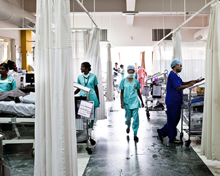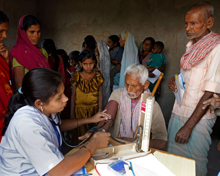Government Health Policies in India
Government Health Schemes in India
 Having embraced a socialist type of public administration after
Independence, governments have tried to usher in an equitable
growth across the country by opening up avenues to realise the
full potential of its citizens.
Having embraced a socialist type of public administration after
Independence, governments have tried to usher in an equitable
growth across the country by opening up avenues to realise the
full potential of its citizens.
On the health front, policies were aimed at improving facilities in the rural areas and expanding the skilled manpower to deliver quality medical services.
For example, the National Health Policy 2002 was aimed at
ushering in an “acceptable standard of health” for the general
population.
 Keeping this in mind, the Eleventh Five Year Plan (2007-12) had
set the goal of achieving good health for people, especially the
poor.
Keeping this in mind, the Eleventh Five Year Plan (2007-12) had
set the goal of achieving good health for people, especially the
poor.
A holistic approach was adopted which included improvements in personalised care, public health, sanitation, clean drinking water, access to safe food and knowledge of hygienic practices.
Government 12th Five Year Plan(2012-17)
The steering committee on health in its report has recommended the 12th Plan should focus on making of the system being able to respond to the healthcare needs of households.
Some of the major targets set for achievement by the end of Twelfth Plan period are:-
Reduction of infant mortality rate (IMR) to 25:
India is projected to have an IMR of 38 by 2015 and 34 by 2017. One of the targets of MDG (millennium development goals) is reducing IMR to 27 by 2015 which would require further acceleration of this historical rate of decline. If this accelerated rate is sustained, the country can achieve an IMR of 25 by 2017. -
Reduction of maternal mortality ratio (MMR) to 100:
At the 5.5% rate of decline per annum, India would have an MMR of 143 by 2015 and 127 by 2017. An achievement of the MDG of reducing MMR to 109 by 2015 would require a further speed up of the decline. If this is sustained, then we can achieve an MMR of 100 by 2017.

-
Reduction of total fertility rate (TFR) to 2.1:
India is on track for the achievement of a TFR target of 2.1 by 2017, which is necessary to achieve net replacement level of unity, and realise the goal of the National Health Policy, 1983 and National Population Policy of 2000. -
Reproductive and child health (RCH) services:
The government has found that it has tackle the social determinants of health to further consolidate the gains made in RCH services. However, the maternal and perinatal mortality is highest in population sub-groups which are poorer, more malnourished, less educated, have lower age of parity and have too many children or too soon.
The Health and Family Welfare division conducts working group discussions with states for finalising their annual plans.
Articles on Health
- Laparoscopic Surgery Advantages
- Laparoscopic Surgery History
- Laparoscopic surgery Procedures
- Limitations of traditional laparoscopic surgery
- New technologies for advance laparoscopic surgery
- Non-Robotic Laparoscopic Surgery
- Robotic Laparoscopic Surgery
- Causes and remedy for dark circles in females

- Harmful impact of mobile phone on unborn baby

- Maternal health care tips

- Rheumatoid Arthritis is Most Widespread in Female
- Periodontal ailment during Pregnancy
- Anemia is prevalent in Women
- Effect of Cell phone tower radiation on human health

- Current health scenario india
- Government health policies india
- Medical facilities india
- Hospital infrastructure india
- Shortage of Medical Professionals in India
- Quality standards indian hospitals
- Indian states health statistics
- Medical expenses india
- Hospitals in Ahmedabad
- Hospitals in Bangalore
- Hospitals in Chennai
- Hospitals in Cochin
- Hospitals in Delhi
- Hospitals in Hyderabad
- Hospitals in Kolkata
- Hospitals in Mumbai
- Hospitals in Pune
- Hospitals in Coimbatore
- Hospitals in Kochi
- Orthopaedics Hospitals in India
- Diabetology Hospitals in India
- Cardiology Hospitals in India
- Infertility Hospitals in India
- Neurology Hospitals in India
- Paediatrics Hospitals in India
- Nephrology Hospitals in India
- Oncology Hospitals in India
- Antiaging foods to improve skin

- Tips for Maintaining healthy bones
- Guidelines for preventing heart disease
- Tips to reduce eye strain while working on computer
- Mental health problems among elderly people
- Health problem of piles

- Health advices for air travel

- Dealing with Allergies
- Tips for Eyes Care
- Care for Crystal Clear Skin
- Tips For Healthy Hair
- Healthy Living is The Absolute Measure of Happiness
- Let Fragrance Rule Your Summer
- Most common vestibular disorder

- Osteoporosis Risk Factors
- Dengue

- Endocrine disorder

- Causes of liver damage
- Dry eye syndrome
- Kidney Stones
- Conjunctivitis: Irritating eye disease
- Anxiety Disorder
- Causes of Brain Damage
- Hepititis B
- Knowledge of Osteoarthritis
- Mental Illness
- Back Pain
- Sugar Addiction
- Diet Control Plans
- General Motors Diet Plan
- No Carbohydrate Diet
- One day Diet Plans
- Seven day diet Plans
- Vegetarian Diet
- Food for Health
- Genetically Modified Foods
- Healing Effects Of Fruits
- Vegetables That Heal
- Healing Effects Of Spices and Herbs
- Test your Stress Level
- Mantras for Relaxation & Stress free life
- Take walk For a healthy body and mind
- Squint is frequently observed in Children
- Consult-Doctor
- Free Handy Health Advice